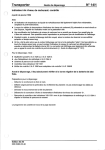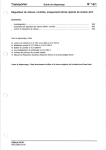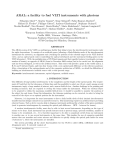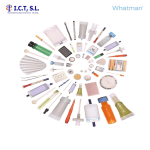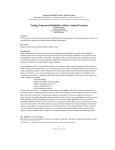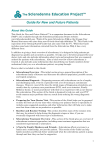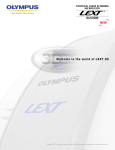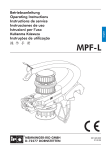Download Latest MDCC manual and protocols
Transcript
MDCC User Manual and Protocols July 2012 MicroDish Culture Chip (MDCC) 1. Introduction to the MDCC The MDCC is a disposable item for culturing microorganisms. It is, basically, a large number of miniaturized “Petri Dishes on-a-chip”. The MDCC has an 8x36 mm footprint, although other configurations are possible. The base of the MDCC is made out of porous aluminium oxide (PAO) with a pore size of about 0.2 µm. This structure allows nutrients from beneath the chip to diffuse through the pores to the surface and consequently supplying microorganisms with nutrients that are growing on top of the surface as microcolonies. Microorganisms cannot penetrate the porous support. The upper surface of the MDCC is divided into individual growth compartments (= microwells). MicroDish BV supplies MDCCs in various designs depending on the envisaged assay. For example, the MDCC180 contains thousands of round compartments that are 180 µm in diameter. The MDCC180 is suitable for the isolation of previously uncultured organisms from complex samples and other analyses where differential growth rates and/or a high degree of segregation is required. The MDCC20 has about 180,000 square wells that are 20 µm across. This chip is applicable for highthroughput screening (HTS) and viable counting. The MDCCs is versatile, allowing the rapid exchange of culture medium, working with difficult organisms, and is highly suitable for imaging and recovery from target microcolonies. Figure 1. View of a MDCC20 chip lying on top of a Petri dish (right) allowing multiplexed culturing compared with conventional culturing of a single strain on agar (left). 2. Sterility The MDCC is usually supplied sterile but in some cases the user might wish to perform their own sterilization procedure. The MDCC can be sterilized by washing with 95% (v/v) ethanol in the supplied tube. Excessive ethanol can be poured off. The remaining ethanol can be evaporated by placing the open tube in a laminar flow cabinet overnight. Do not remove ethanol by flaming. www.microdish.nl 1 MDCC User Manual and Protocols July 2012 Alternatively, chips can be sterilized using ultraviolet light, plasma cleaning or gamma radiation. Normal power and time settings, as used for sterilizing dry glassware or plastics, are recommended. Sterilization by autoclaving and dry heat are not appropriate. 3. Chip Handling Orientation – shiny side is UP, this side is where microorganisms can be inoculated. The dull grey surface is the underside of the chip that should contact the nutrient source, such as an agar plate. To place the MDCC on an agar plate, open the tube under sterile conditions and gently tap the tube until one end of the chip contacts the agar. Then gently withdraw the tube so the chip lies flat with the shiny side upwards. Several ways are possible to move a MDCC from one agar plate to another. Such an operation might be required when moving a chip from an agar plate to a staining slide. It is left to the individual user which technique to apply. Possible procedures are: 1. Chips can be moved and transferred to a different agar plate by gently lifting them with a piece of laboratory parafilm. To do so, gently slide a piece of sterile parafilm between the MDCC and the agar then lift the MDCC to the new location. 2. A very thin spatula (5-10 mm width) can be used to lift up the MDCC. For this, carefully place the tip of the spatula at the short end of the MDCC, lift it up by 1-2 mm and then slowly slide it under the MDCC. While lifting the chip up, transfer it to the new location. The transfer of the MDCC should occur as quickly as possible to prevent the cells from drying out. Dry chips can be manipulated with tweezers but are brittle, so some care is required. 4. Inoculation Inoculation is done by pipetting or gently spreading microorganisms on the upper surface of the chip. In HTS, it is recommended to plate organisms with a probability of growth in any given compartment of < 5% to ensure good separation – in other words not every compartment has to contain a microcolony for an effective screening – it is often better to ensure that most compartments that support growth are a monoculture. The MDCC180 can be inoculated effectively with 5 µl droplets of the sample. It is advisable to use a dilution series in order to find the optimum dilution. Higher dilutions increase the possibility that the wells contain microcolonies derived from a single species. This is an effective strategy when isolating previously uncultured organisms. 5. MDCC Chemical Stability and Incubation Conditions. Incubation can be performed at temperatures between 4 and 60°C and a pH between 3 to 9. Incubation at elevated temperatures (up to 90°C) is possible for a limited time (max. two weeks). The MDCC is limited resistant to ethanol, methanol, dimethylformamide and DMSO but not to acetone. www.microdish.nl 2 MDCC User Manual and Protocols July 2012 6. Staining Staining can be performed by introducing a fluorogenic dye from underneath the MDCC without disturbing the microcolonies on the chip surface, as described in Section 7. Imaging (Fluorescence Staining Protocol). 7. Imaging Imaging is best performed using microscope objective lenses that do not touch the MDCC chip (except using a cover slip and/or immersion oil). Depending on the magnification, areas from a few mm2 to 10 µm2 can be imaged in a single field of view. Figure 2. Section of a MDCC160 chip on an agar plate using transmitted light microscopy. A and B are compartments that contain microcolonies. Microorganisms can overgrow individual wells as depicted in C, which is not an issue at this point. Targeted strain recovery is even eased in such a case. Fluorescence Light Microscopy: Intrinsic fluorescence (e.g. GFP) and fluorogenic strains can be used as the MDCCs are low in autofluorescence. Very intense stains can help to detect a higher amount of microcolonies on a MDCC. It is also possible to identify specific microorganisms in HTS depending on the applied dye. It is recommended to use Fluorotar lenses or other objectives suitable for fluorescence microscopy. Microorganisms grown on the MDCC can be stained using solidified agarose containing the dye as described below. www.microdish.nl 3 MDCC User Manual and Protocols July 2012 Fluorescence Staining Protocol A. Pour 1 ml of barely molten low-melting point agarose containing the dye on a standard microscope slide. Typically, use the concentration recommended by the manufacturer for staining in liquid culture or slightly higher. Other components (e.g. growth medium, cofactors) may be added to the low melting point (LMP) agarose. If the dye is robust at high temperatures conventional agarose can be used. B. Allow the LMP agarose to solidify in the dark (to project the applied dye from photobleaching) at room temperature, typically for 1 h. C. Transfer the MDCC onto the dye slide and incubate for a specific period. As guideline, an incubation time of 30 minutes at room temperature should be sufficient for nucleic acid stains. Note: The LMP should be gelled and not too wet prior staining as this might result in redistribution of microcolonies on the MDCC. D. The MDCC containing stained microorganisms is ready for imaging or might be transferred to a second LMP slide (without dye) for de-staining purposes. Figure 3. A section of a MDCC20 chip using fluorescence microscopy equipped with a 10x Fluorotar objective lens. Escherichia coli strain XL2Blue expressing GFP was grown on the chip. The picture was taken with a black and white CCD camera. Compartments filled with GFP expressing cells appear white whereas empty ones are darker with a brighter rim. Dissection Microscope: A relatively low powered microscope (total magnification 4x to 20x) is also suitable for imaging. Light is most effective from above, ideally at a 45° angle. This is an effective method when monitoring a chip over a period of time, for example as part of a procedure to recover growing microcolonies. USB microscopes may also be suitable. Note: Not all cultures within the MDCC may be visible by this method. www.microdish.nl 4 MDCC User Manual and Protocols July 2012 Figure 4. Section of a MDCC160 using a dissecting microscope (10x). Microcolonies can be seen in some of the compartments, which appear white over the entire well surface. Here, illumination was from above at a 30° angle. Scanning Electron Microscopy (SEM): It is recommended to fixate microcolonies prior SEM imaging. SEM fixing Protocol: A. Prepare an agar plate containing the SEM fixative. Other components (e.g. growth medium, cofactors) may be added to the agarose. Note: Fixatives might be harmful. In such a case, plates are best poured using barely molten agar in a fume hood that protects the user from the fixative. B. Allow the agarose to solidify at room temperature, typically for 1 h. C. Transfer the MDCC onto the agar plate and incubate. Note: The agarose should be gelled and not too wet prior fixation as this might result in redistribution of microcolonies on the MDCC chip. D. The MDCC chip containing fixed microorganisms is ready for imaging. 8. Recovery of Samples It is possible to recover microcolonies within the individual MDCC wells. A sharp, sterilized toothpick can be used to remove microorganisms from the compartments. Microcapillaries or fragments of fibre optic cables or laser capture dissection microscopy may also be suitable. The critical aspect of recovery is the imaging method, we recommend dissection or transmission light microscopy using lenses with a working distance of about 1 cm. Recovery of microcolonies stained by fluorogenic dyes is possible (for example, as part of HTS), although viability might be reduced depending on the toxicity of the applied dye. In general, it is advisable to use an automated X,Y-stage allowing the user to return to a specific position on the MDCC. The use of a micromanipulator might additionally help when recovering a sample. www.microdish.nl 5 MDCC User Manual and Protocols July 2012 9. Possible Procedures after Recovery The recovered material can be used for PCR amplification. Such a procedure might be applied for identification purposes by sequencing 16S rRNA encoding genes. Alternatively, cells can be inoculated for multiple displacement amplification (MDA) reactions for whole genome sequencing. Recovered microcolonies can be transferred onto poly-L-lysine glass slides for FISH analysis, immunofluorescence or negative staining. Inoculation of recovered cells into specific growth media for further cultivation. 10. Plasma Cleaning MDCC Plasma cleaning is a method for decontamination and for increasing the hydrophilicity of surfaces. Plasma is a partially ionized gas and includes free electrons that vaporizes hydrocarbons from a surface, which are immediately and completely removed. This cleaning method is often superior to solvent cleaning methods. Plasma cleaning does not prevent the re-adsorption of material onto the cleaned surface – storage under vacuum is therefore recommended. Plasma treatment can be used to make the MDCC chip more hydrophilic and to fine tune the surface chemistry. Plasma Cleaning Protocol A. Wash the MDCC chip briefly with methanol, air dry and place it on a clean microscope slide (compartments up) inside the plasma chamber. Use a sterile microscope slide if necessary. B. Create the vacuum in the plasma chamber according to the normal protocols for the used device. C. Treat chips with plasma (starting with 15 sec at lowest power for platinum treated chips and 10 sec if uncoated). If the chip starts to curve, the plasma treatment has been too extensive. D. Remove the chip. The chip can be briefly treated with ethanol, UV- or gamma-radiation for sterilization purposes. The necessity of this step will depend on the quality of the air supply and has to be considered individually. www.microdish.nl 6 MDCC User Manual and Protocols July 2012 11. Troubleshooting Inoculation takes a while to dry. Patience is advised. Sometimes the surface chemistry does cause wetting to be delayed in time. The agar plates should be solidified before the MDCC is deployed. Washing with methanol and/or plasma cleaning can be used to make the MDCC more hydrophilic if necessary (Section 10. Plasma Cleaning MDCC). Overgrowth of microcolonies. The individual compartments on the MDCC will eventually be overgrown. This will occur faster with the MDCC20 as the wells are small and the walls are only 10 µm high. It is recommended to use the MDCC180 for culturing complex samples (e.g. in which some strains grow much faster than others). The chip breaks. Shear forces should be avoided. It is recommended to slide a small piece of laboratory parafilm or a very thin spatula under one corner of the MDCC until the chip can be lifted and transferred to a different location. Note: Broken pieces can still be used. 12. Frequently Asked Questions Can you custom build chips? Yes! Various MDCC designs are available. Please contact MicroDish B.V. for more information. Can I cut chips? This is not advisable. Can I reuse chips? The MDCCs are designed as disposable items. I see faint rings around the edges of compartments when using fluorescence microscopy, why? This is autofluorescence of the material and a result of chip manufacturing. It can be a useful feature enabling identification of compartments. 13. References Staining and SEM protocols suitable for MDCC: Ingham, CJ, van den Ende M, Pijnenburg, PC, Wever, PC and Schneeberger, PM (2005) Growth of microorganisms in a multiplexed format on a highly porous inorganic membrane (Anopore) App Environ Micro 71:8978-8981. Ingham, CJ, van den Ende M, Wever, PC and Schneeberger, PM (2006) Rapid antibiotic sensitivity testing and trimethoprim-mediated filamentation of clinical isolates of the Enterobacteriaceae assayed on a novel porous culture support Journal Medical Microbiology 55:1511-1519. www.microdish.nl 7 MDCC User Manual and Protocols July 2012 Hesselman MC, Ingham CJ et al. A multi-platform flow device for microbial (co-)cultivation and microscopic analysis. PLoS ONE 2012;7(5):e36982 Ingham CJ, Sprenkels A, Bomer JG, van den Berg, A, and van Hycklama Vlieg, JET. (2010) Highresolution contact printing and transfer of massive arrays of microorganisms on porous aluminium oxide. Lab on a Chip 10:1410-1416. The MDCC20 chip: Ingham CJ, Sprenkels, A, Bomer JG, Molenaar, D, van den Berg, A, van Hycklama Vlieg, JET and de Vos, WM (2007). A highly subdivided microbial growth chip constructed on a porous ceramic support. PNAS 46:18217-18222. Contact information: MicroDish B.V. Kruytbuilding Padualaan 8 3584 CH Utrecht The Netherlands T +31 (0)30 25 38 298 E [email protected] www.microdish.nl This is proprietary information of MicroDish BV and is intended as guideline for usage. No guarantee for a particular application can be given. CAUTION: Not intended for human or animal diagnostic or therapeutic use. The General Terms and Conditions of MicroDish B.V. apply. www.microdish.nl 8








